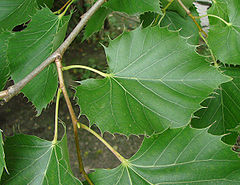Tilia henryana
| Tilia henryana subsp. var. | Henry's Lime | |||||||||||||||||||||||||||||||||||||||||||||||||||||||
|---|---|---|---|---|---|---|---|---|---|---|---|---|---|---|---|---|---|---|---|---|---|---|---|---|---|---|---|---|---|---|---|---|---|---|---|---|---|---|---|---|---|---|---|---|---|---|---|---|---|---|---|---|---|---|---|---|

|
|
| ||||||||||||||||||||||||||||||||||||||||||||||||||||||
| ||||||||||||||||||||||||||||||||||||||||||||||||||||||||
Tilia henryana Szyszyl., commonly known as Henry's Lime, is a medium-sized deciduous tree native to the provinces of Anhui, Henan, Hubei, Hunan, Jiangsu, Jiangxi, Shaanxi, and Zhejiang in China [1].
Introduced to the West by Ernest Wilson in 1901, the tree grows to 25 m tall, its bark pale grey and fissured. The sea green leaves are cordate, < 10 cm long, with distinctive ciliate margins, and are borne on 3 - 5 cm petioles. The tiny pale, almost white, fragrant flowers appear in clusters of up to 20 in autumn. The tree grows very slowly in cultivation, and performs best in sheltered locations [2].
Cultivation
Propagation
Pests and diseases
Varieties
Two varieties are recognized, var. henryana and var. subglabra, principally distinguished by branchlets that are yellow, stellate tomentose, and glabrous, resp.
Gallery
References
- ↑ Tang, Y., Gilbert, M. G., & Dorr, L. J. Tiliaceae, in Wu, Z. & Raven, P. (eds) (2007). Flora of China, Vol. 12. Science Press, Beijing, and Missouri Botanical Garden Press, St. Louis, USA. ISBN 10-193-072340-7 [1]
- ↑ White, J. & More, D. (2003) Trees of Britain & Northern Europe. Cassell's, London. ISBN 0-304-36192-5
External links
- w:Tilia henryana. Some of the material on this page may be from Wikipedia, under the Creative Commons license.
- Tilia henryana QR Code (Size 50, 100, 200, 500)


